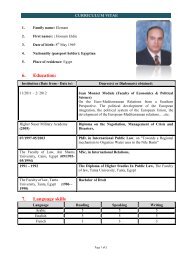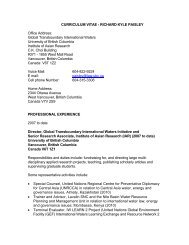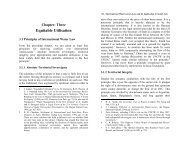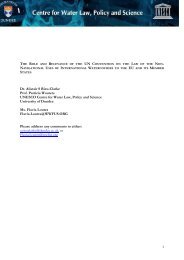Upreti, Trilochan, International Watercourses Law and Its Application ...
Upreti, Trilochan, International Watercourses Law and Its Application ...
Upreti, Trilochan, International Watercourses Law and Its Application ...
You also want an ePaper? Increase the reach of your titles
YUMPU automatically turns print PDFs into web optimized ePapers that Google loves.
60 / <strong>International</strong> <strong>Watercourses</strong> <strong>Law</strong> <strong>and</strong> <strong>Its</strong> <strong>Application</strong> in South Asia Development <strong>and</strong> Codification of <strong>International</strong> <strong>Watercourses</strong> <strong>Law</strong> / 61water between a mighty <strong>and</strong> weak neighbour whereby the treatyensured Mexico’s reasonable <strong>and</strong> equitable share.2.7. 3 The Nile River Treaty, 1929 & 1959 Egypt-SudanThe first treaty safeguarded Egypt's existing <strong>and</strong> historic rights<strong>and</strong> gave all of the benefits to her, neglecting Sudan <strong>and</strong> sevenother upper riparian states’ legitimate rights over the waters ofNile. Although, this earlier treaty was concluded under theBritish colonial regime both in Egypt <strong>and</strong> Sudan, it protectedEgypt’s interest at Sudan's cost over the shared water resources.The most striking issue in both treaties is that although there arenine riparian states within the Nile watercourses, the treaty wasconcluded only between two co-riparians. 109 After thedecolonisation of Sudan, she rejected outright the earlier treatystating that it had been made by an alien power, not by thelegitimate representatives of Sudan. As a result, a new treatywas concluded. This treaty protected some interests of Sudan,which had not been covered by the earlier one. However, it stillrecognised the historic rights of Egypt. The main features of thearrangement involve sharing on the basis of the volume ofwater, whereby Sudan received 4 billion cubic metres (CM),<strong>and</strong> Egypt 48 billion CM.The case of the Nile River is extreme in IWL. The fact is thatEgypt did not contribute any waters from her territory. UnlikeEgypt, Ethiopia which contributes most of the waters in BlueNile, the main tributary of the Nile has been prohibited fromutilising the Blue Nile waters even within her own territory. 110Egypt has been continuously using these waters since timesdating back to the ancient Nile civilisations. In the givencircumstances, utilisation of the waters by the upper riparianstates could be a severe blow to Egypt <strong>and</strong> she had already109 Supra note 36, p. 65.110 T. Naff & R. C. Matson, Water in Middle East: Conflict or Cooperation,Colorado: Westview Press, 1984, pp. 1-16.declared that such utilisation would not be acceptable to her. 111Moreover, Egypt had declared that to deprive her of thesewater rights was to prepare for war with her. 112 In this treaty,the principle of no harm <strong>and</strong> Egypt's prior appropriation hasbeen heavily advocated <strong>and</strong> the principle of equitableutilisation has been largely ignored.The fact is that Egypt managed to develop a huge network ofirrigation canals through a gigantic barrage in order to useevery drop of water of the Nile. As the western governments<strong>and</strong> the World Bank refused to finance this work because ofthe riparian issues, the then Soviet Union assisted technicallyas well as financially in order to carry out such a gr<strong>and</strong>ioseproject, ignoring the interest of other eight riparians in the Nilewaters. Ethiopia <strong>and</strong> others are not able to use this water,despite the fact that they are entitled to their share of it,because international assistance is required in order to developany project with no objection from other riparians includingEgypt, which naturally would object to the proposal on thegrounds of historic use. 113 In this circumstance, the principleof equitable utilisation has been subordinated to the no harmrule, which is being advocated by Egypt. However, recentlyEgypt <strong>and</strong> her upstream states have been working together toachieve a fair, just <strong>and</strong> equitable utilisation of these waters111 S. E. Smith & Hussein M. Rawly, "The Blue Nile: Potential forConflict <strong>and</strong> Alternatives for Meeting Future Dem<strong>and</strong>" (1990) in 15WI, p. 220.112 N. Kliot, Water Resources <strong>and</strong> Conflict in the Middle East, London:Routledge, 1994, p. 68.113 A. H. Garretson, “The Nile Basin”, in A. Garreston et al (eds), The<strong>Law</strong> of <strong>International</strong> Drainage Basins, New York: Oceana Pub., 1967,pp. 275: The World Bank <strong>and</strong> the western government refused toprovide loans <strong>and</strong> other assistance in developing the Aswan dam in1965. It was because the riparian issue was not resolved.












